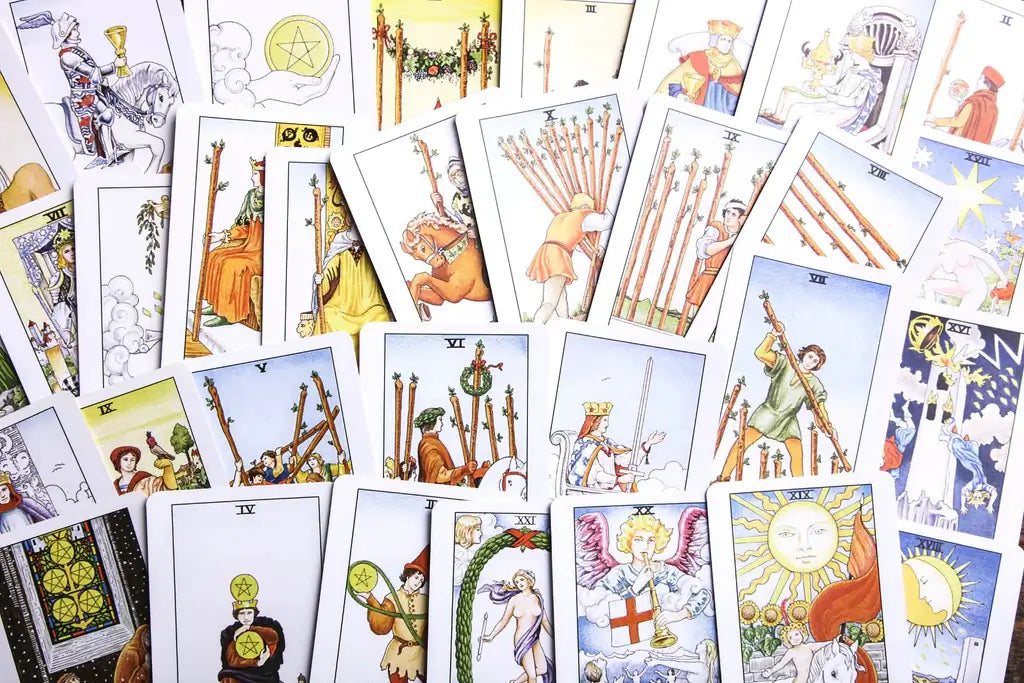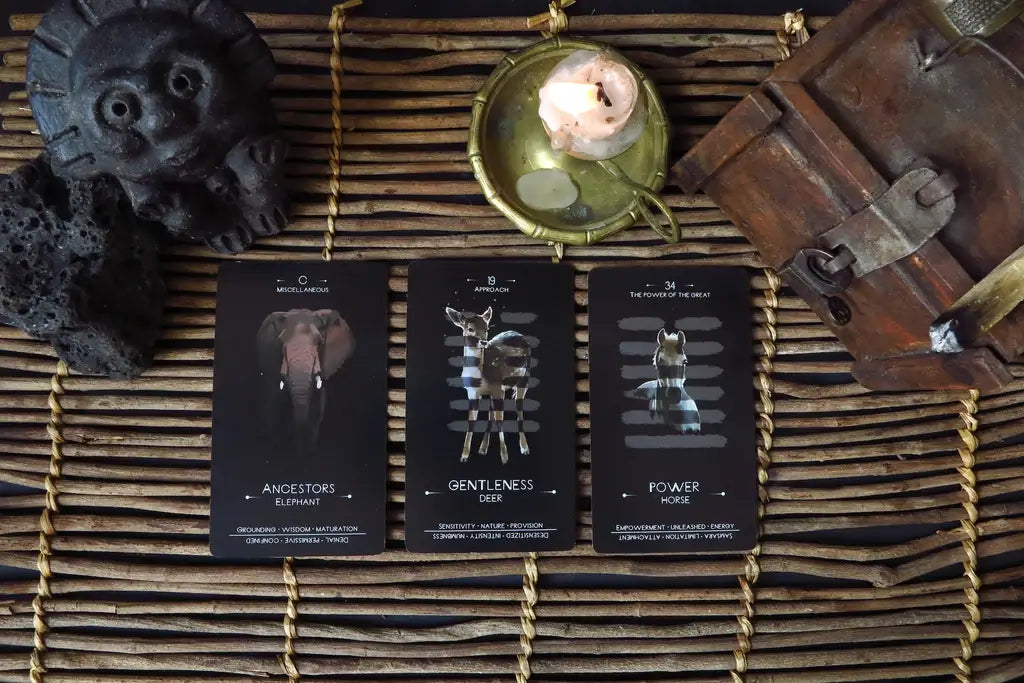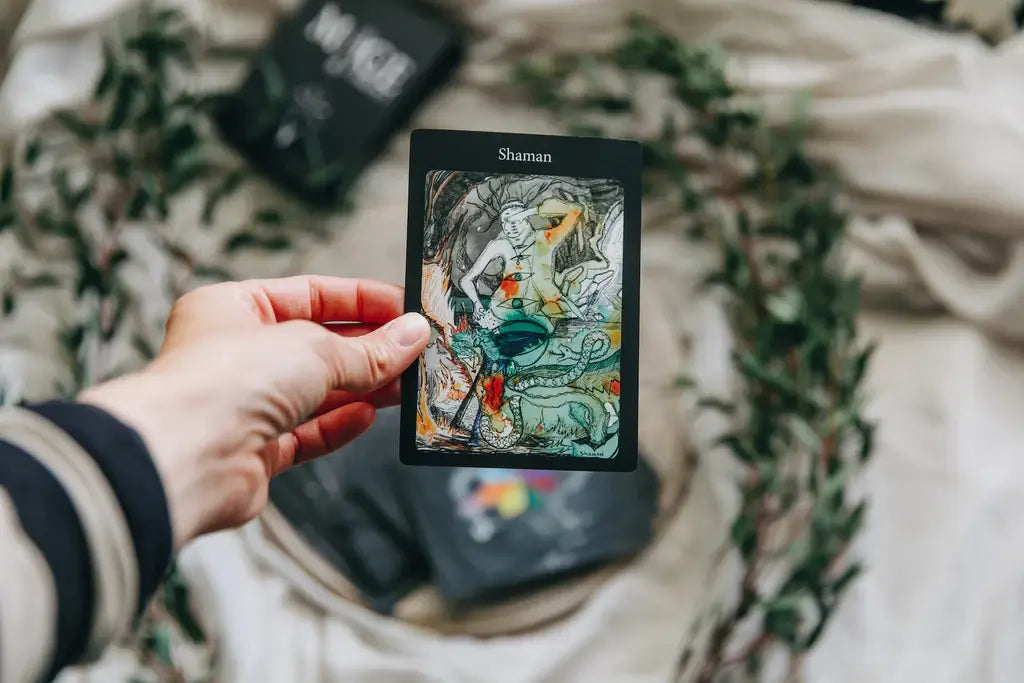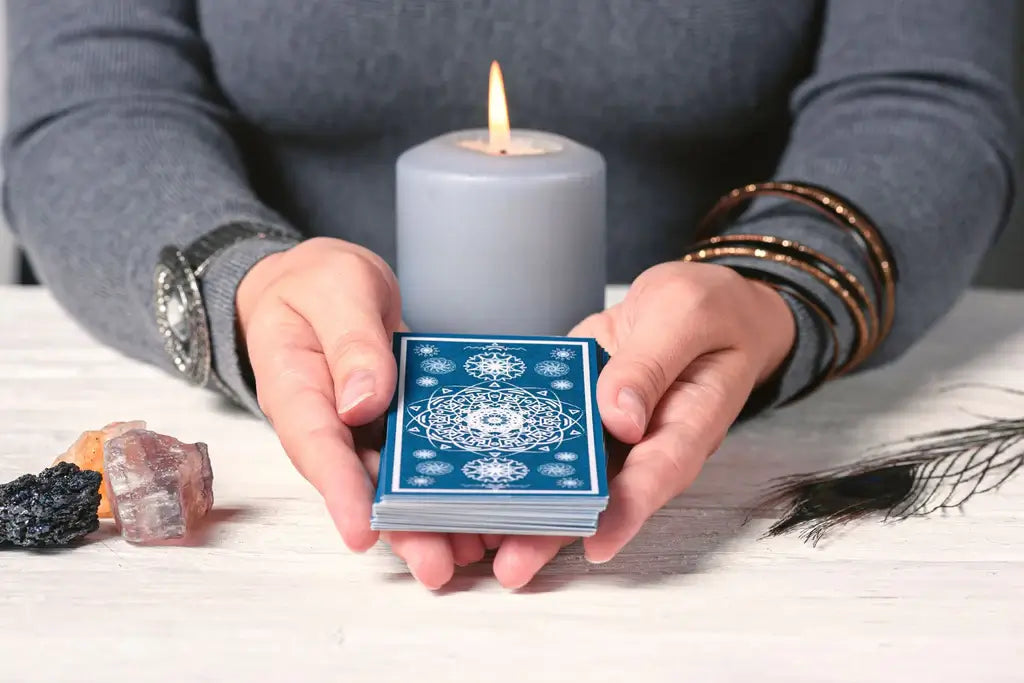
Audio Version (Press Play & Scroll Seamlessly Through the Article ▶️🎶)
You've probably heard about divination—the practice of seeking knowledge of the future or the unknown by supernatural means—and spiritual guidance, which involves reaching out to higher powers or inner wisdom for advice and understanding.
There are an endless number of tools for divination and spiritual guidance. In this post, we're going to focus on two of the most captivating and popular ones: oracle cards and tarot cards.
You've probably seen them around—beautifully illustrated decks, each card rich with symbolism and mystery.
But what exactly are these decks? We'll explore the origins, structures, uses, and even the limitations of both oracle and tarot cards.
And most importantly, we're going to address the burning question: Oracle cards vs tarot cards—what's the difference?
Table of Contents
- Understanding Oracle Cards
- Exploring Tarot Cards
- Oracle Cards vs Tarot Cards: The Key Differences
- Comparison of Structure and Design
- Learning Curve and Mastery
- Purpose and Intention
- Variations in Usage and Interpretation
- Predictive Abilities and Detail Level
- Flexibility and Adaptability
- Suitability for Different Kinds of Readers and Seekers
- Key Takeaways
Understanding Oracle Cards

Oracle cards are captivating, often colorful, and deeply symbolic decks and have been a source of insight and introspection for many.
Origins of Oracle Cards
Unlike their tarot siblings, the origins of oracle cards are a bit harder to pin down. That's because 'oracle cards' is a kind of catch-all term for any deck that doesn't fit the strict structure of the tarot (which we'll get to later).
Oracle decks are inspired by ancient traditions and mythology, others by nature, and some are born purely from the creative imagination of their creators. What they all share is their purpose to offer insight, guidance, and a fresh perspective to those who use them.
Structure of an Oracle Deck
1. Number of Cards
Oracle decks are like the free spirits of the divination world; they're not bound by rules or specific structures. A deck can contain any number of cards, often anywhere from 20 to 60, or even more. It all depends on the oracle deck creator's vision.
2. Meanings and Symbols
Each card in an oracle deck carries a unique message, typically expressed through a combination of text and imagery. These could be direct, like 'Strength' or 'Love,' or more abstract, like 'The Sacred Pool' or 'Dragonfly Spirit.' The symbols used can be as varied as the deck itself and are meant to provoke reflection and intuition.
How Oracle Cards are Used
So how exactly do we use these creative decks?
1. For Reflection and Meditation
Oracle cards are a favorite tool for daily reflection or meditation.
- Draw a card from the deck
- Consider its message, and meditate on what it means for you
- The cards can offer a fresh perspective, a dose of inspiration, or even a challenge to shift your thinking
2. For Spiritual Guidance
Oracle cards can also serve as spiritual guides, helping us navigate our thoughts, feelings, and life's big (or small) questions, offering wisdom and insight to help you make your own choices.
Benefits and Limitations of Oracle Cards
Oracle cards have both perks and quirks.
Their flexibility makes them approachable, especially for beginner card readers. They're open to interpretation, and because each deck is so unique, you can find one that truly resonates with you.
However, this lack of structure can also be a challenge. The wide variation means there's no standard 'how-to' guide, so it might take some time and intuition to connect deeply with a deck. Also, while oracle cards are wonderful for personal reflection and guidance, they may not offer the level of detail that other tools, like tarot cards, can provide.
But remember, oracle cards—like any tool for reflection or divination—are about personal connection and intuition. So if you feel drawn to them, you should definitely give them a try.
Exploring Tarot Cards

If you thought oracle cards were intriguing, wait till you dive into the world of tarot cards!
Origins of Tarot Cards
Tarot cards date back to mid-15th C Europe, and have a rich history. They began as a card game among the Italian nobility and weren't associated with mysticism or divination until centuries later.
Fast-forward to today, and tarot cards are a popular tool across the globe for introspection, clarity, and spiritual guidance.
Tarot Deck Structure
A standard tarot deck contains 78 cards, split into two 'arcana'.
1. Major Arcana
These are the 'big guns' of the tarot world—22 cards representing life's significant events and spiritual lessons. Cards like 'The Fool', 'The Lovers', and 'Death' belong here, each packed with symbolism and carrying profound messages.
2. Minor Arcana
These are a set of 56 cards that depict the daily ups and downs of life. They're split into four suits—Cups, Pentacles, Swords, and Wands—each corresponding to a specific element (water, earth, air, fire), and encompassing a range from Ace to Ten, plus four court cards: Page, Knight, Queen, and King.
How Tarot Cards are Used

1. In Psychic Readings
Tarot cards are very popular in psychic readings and are used to shed light on the past, present, and the potential future. It's important to note, though, that tarot cards are not about predicting a fixed destiny or the future. What tarot cards, when read properly, excel at is illuminating potential outcomes based on an individual's current paths or behaviors.
2. Tools for Spiritual Insight and Personal Growth
Tarot cards serve as powerful tools for introspection and personal growth.
For example...
- You can simply pull a card from the deck for daily reflection
- Use them to dig deep into personal issues
- Use them to reveal layers of understanding and insight
Limitations of Tarot Cards
The structure tarot cards offer, is a detailed and nuanced way to explore life and an individual's spiritual journey. The specific meaning of each card along with its position and relation to other cards in a tarot spread can provide an incredible depth of insight.
But, as with anything, there are limitations. The complexity of learning tarot may be intimidating for beginner readers, as tarot requires time and practice to understand and interpret the layers of symbolism and meaning.
However, once you learn and practice using the cards, your tarot journey can be a rewarding one, offering endless opportunities for growth, discovery, and a deeper understanding of your life's path. So, if tarot is calling you, don't hesitate—dive in and explore!
Oracle Cards vs Tarot Cards: The Key Differences
We've explored oracle cards and tarot cards separately, but now it's time to put them head-to-head. How do they differ? Let's delve deeper.
Oracle Cards vs Tarot Cards - Comparison of Structure and Design

A tarot deck, as seen above, has exactly 78 cards, an oracle deck has no set number of cards
1. Number and Structure of Cards
As we discussed earlier, oracle cards are free-spirited. The number of cards in a deck can vary widely, and there's no set structure or standard symbolism across decks. On the other hand, tarot decks stick to a standard 78-card structure, split into the Major and Minor Arcana, each card carrying a specific meaning.
2. Design and Artwork
Both types of decks can feature a variety of artistic styles, from abstract and whimsical to realistic and traditional. Oracle cards, though, often come with a word or phrase on each card to guide interpretation, while tarot relies heavily on specific imagery and symbolism tied to traditional meanings.
3. Themes and Focus
Oracle decks can cover a wide range of themes—nature, angels, animals, goddesses, and more. Tarot decks, however, while they can vary in artistic interpretation, still maintain the core symbolism and themes inherent in the traditional tarot structure.
Oracle Cards vs Tarot Cards - Learning Curve and Mastery

An oracle deck follows a fluid system while a tarot deck is structured
1. Ease of Learning
Oracle cards, with their straightforward messages and lack of set structure, are often easier for beginners to start with. Each card usually carries a self-contained message, and you're encouraged to interpret that message intuitively. On the other hand, tarot cards have specific meanings attached to each card, and understanding these meanings—plus the context within spreads—can take considerable study.
2. Mastery and Depth
While oracle cards can be easier to start with, tarot cards offer a depth and complexity that some find more rewarding in the long run. Tarot readers often spend years, even decades, delving into the symbolism, numerology, and historical context of the cards to deepen their readings. Tarot study can become a lifelong journey.
Oracle Cards vs Tarot Cards - Purpose and Intention

Oracle decks have their own "lexicon" or symbolic language based on the theme of the deck
1. Self-Reflection vs. Situation Analysis
While both oracle and tarot cards can be used for introspection and guidance, oracle cards tend to be more focused on personal development, self-reflection, and affirmation. They're often used to inspire thought and introspection.
Every oracle deck is unique, created by its designer with a particular intention, style, and set of meanings. Some decks might draw from ancient mythologies, while others might use modern imagery, animals or abstract symbols.
To use an oracle deck effectively, it's beneficial for the reader to become familiar with its specific lexicon (the collection or set of symbols, images, words, and concepts present in a particular oracle deck), usually by studying the guidebook that accompanies the deck or through regular use and meditation on the cards.
Tarot cards, while also used for personal insight, can provide a more comprehensive analysis of a situation or relationship and can provide potential future outcomes based on the querent's current path.
2. Positive Affirmation vs. Challenging Insights
Oracle decks are often (though not always) designed to provide uplifting and positive messages. While they can challenge you, they typically do so gently and affirmatively. Tarot, on the other hand, can bring up challenging insights more directly, as it includes cards that represent difficult experiences or emotions, which, while they can be tough, can also lead to significant personal growth and understanding.
Both oracle cards and tarot cards are powerful tools in their own rights. It's all about choosing the tool that resonates most with you, your current situation, and your personal spiritual journey.
Oracle Cards vs Tarot Cards - Variations in Usage and Interpretation

Oracle readings may not follow a specific pattern, whereas Tarot often uses established spreads for readings
1. Readings and Spreads
With tarot cards, there are established spreads, like the three-card past-present-future or the more complex Celtic Cross. These can provide nuanced readings about specific situations. Oracle cards, on the other hand, lend themselves well to single-card draws or any spread that the reader feels intuitively drawn to use. Their flexibility allows for more freedom in the reading process.
2. Interpretation
The interpretation of tarot cards involves understanding the traditional meanings of the cards, their placement in the spread, and their relation to each other. Oracle cards, with their direct messages and free-form structure, can be more straightforward and intuitive to interpret. However, the meanings can also be more subjective, depending on the specific deck and the intuition of the reader.
Oracle Cards vs Tarot Cards - Predictive Abilities and Detail Level

Both Tarot and Oracle cards can suggest potential outcomes, with Tarot being perhaps more predictive
1. Depth and Detail
When it comes to offering in-depth and detailed insights, tarot cards often come out ahead. With a clear and structured system, tarot can provide clear-cut answers, and even suggest potential outcomes based on current circumstances, relationships and situations.
Each card in a tarot spread influences and is influenced by the cards around it, which can create a detailed narrative about the situation at hand.
2. Predictive Abilities
Although both oracle and tarot cards can give you a glimpse of potential future outcomes, they don’t predict the future in a concrete way. What they do is highlight the energies or influences in your life, and show you a likely outcome based on your current path. However, because of their detailed nature, tarot cards are often viewed as more predictive than oracle cards.
Oracle Cards vs Tarot Cards - Flexibility and Adaptability

Oracle decks can be any theme with no set structure, Tarot decks can also be any theme but with a set structure
1. Personalization
Oracle cards offer more flexibility and can be easily personalized. Since there's no set structure, you're free to use them in a way that works best for you. For example, you might decide to draw one card each morning for daily guidance, or use a specific spread that suits your needs. With tarot, while there's room for intuition, readings typically adhere to traditional meanings and established spread structures.
2. Adaptability to Different Contexts
Oracle cards can be easily adapted to various contexts and themes due to their flexible nature. There are oracle decks for virtually every theme you can imagine, from self-love and daily inspiration to angel messages and shamanic healing. Tarot decks, while they come in many artistic styles and themes, maintain a consistent symbolic structure across all decks.
Oracle Cards vs Tarot Cards - Suitability for Different Kinds of Readers and Seekers

Would you choose Tarot, Oracle or both?
1. Beginners vs. Experienced Readers
For those new to card reading, the freedom and simplicity of oracle cards can be a good place to start. They offer a gentle introduction to using intuition to interpret cards. Tarot, while it might present a steeper learning curve with its complex symbolism, can be deeply rewarding and offers a structured system to learn and grow with over time.
2. Specific Questions vs. General Guidance
If you have a specific question or situation you want insight into, tarot's detailed and structured system can offer nuanced insights. For broader guidance, inspiration, or affirmation, oracle cards can be an excellent choice. They can provide clear and direct messages that are easy to relate to your overall life or your spiritual journey.
3. Personal Resonance
At the end of the day, the choice between oracle cards and tarot cards comes down to personal resonance.
- Which deck are you drawn to?
- Which feels right in your hands and in your heart?
- Which interpretations are more meaningful and apply more to your situation and life?
You might find that using both oracle and tarot cards in tandem works best for you. There is really no wrong choice.
Key Takeaways
We've traveled through the realms of oracle vs tarot cards, exploring their origins, structures, uses, and unique attributes. We've also delved into the differences between these two powerful spiritual tools.
- Structure and Design: Tarot cards follow a structured system of 78 cards divided into the Major and Minor Arcana, each with traditional meanings. Oracle cards, on the other hand, are the free spirits of the divination world—with varying numbers of cards, flexible structures, and often featuring guiding words or phrases.
- Usage and Interpretation: Tarot offers detailed and intricate readings and is often preferred for answering specific questions. Oracle cards, with their more straightforward messages, are excellent for broad guidance, reflection, and daily inspiration.
- Suitability: Tarot can be more challenging for beginners due to its complexity but offers a rich depth for ongoing study. Oracle cards might be easier to start with and offer a lot of flexibility for personalization.
- Predictive Abilities and Detail Level: Both can provide insights into potential outcomes, but tarot's detailed nature often makes it seem more predictive.
- Flexibility and Adaptability: Oracle cards shine in their ability to be tailored to various contexts and themes, while tarot maintains a consistent symbolic structure.
- Learning Curve and Mastery: While tarot might take longer to master due to its detailed symbolism, it can offer a rewarding lifelong study. Oracle cards are often easier for beginners and encourage intuitive interpretation.
- Purpose and Intention: Oracle cards often focus more on personal development and self-reflection, while tarot provides a comprehensive analysis of situations or relationships.
So, there we have it, our deep dive into oracle cards vs tarot cards. Remember, no matter which path you choose—whether the structured depth of tarot, the free-spirited nature of oracle, or a beautiful blend of both—the magic is in your hands. Enjoy this beautiful journey, and may the cards always guide you towards light, love, and understanding.
Whenever you're ready, there are 4 ways I can help you:
1. Tridevia Tarot Deck: Join hundreds of cosmic explorers and spiritual enthusiasts in discovering the Tridevia Golden Foil 78-Card Tarot Deck, featuring enlightening affirmations in a luxurious collector’s box. Embark on a transformative journey of self-discovery and divine guidance.
2. Enlightening Tarot Courses: Join our vibrant community of spiritual seekers and take our Tridevia Tarot Deck courses. Tranform your life and elevate your readings with Tarot Meditations, Manifesting Daily, Creating Flow and Wealth, Unlocking Fertility and more.
3. FREE Mystical Tarot Guide: Yours for Free! This guide will help you master 78 cards in any deck and discover unique spreads for profound insights.🎁
4. Calmoura Tarot Academy: Follow our YouTube channel for eye-opening insightful videos and everyday tarot inspiration to help rewire your brain and change your life.


